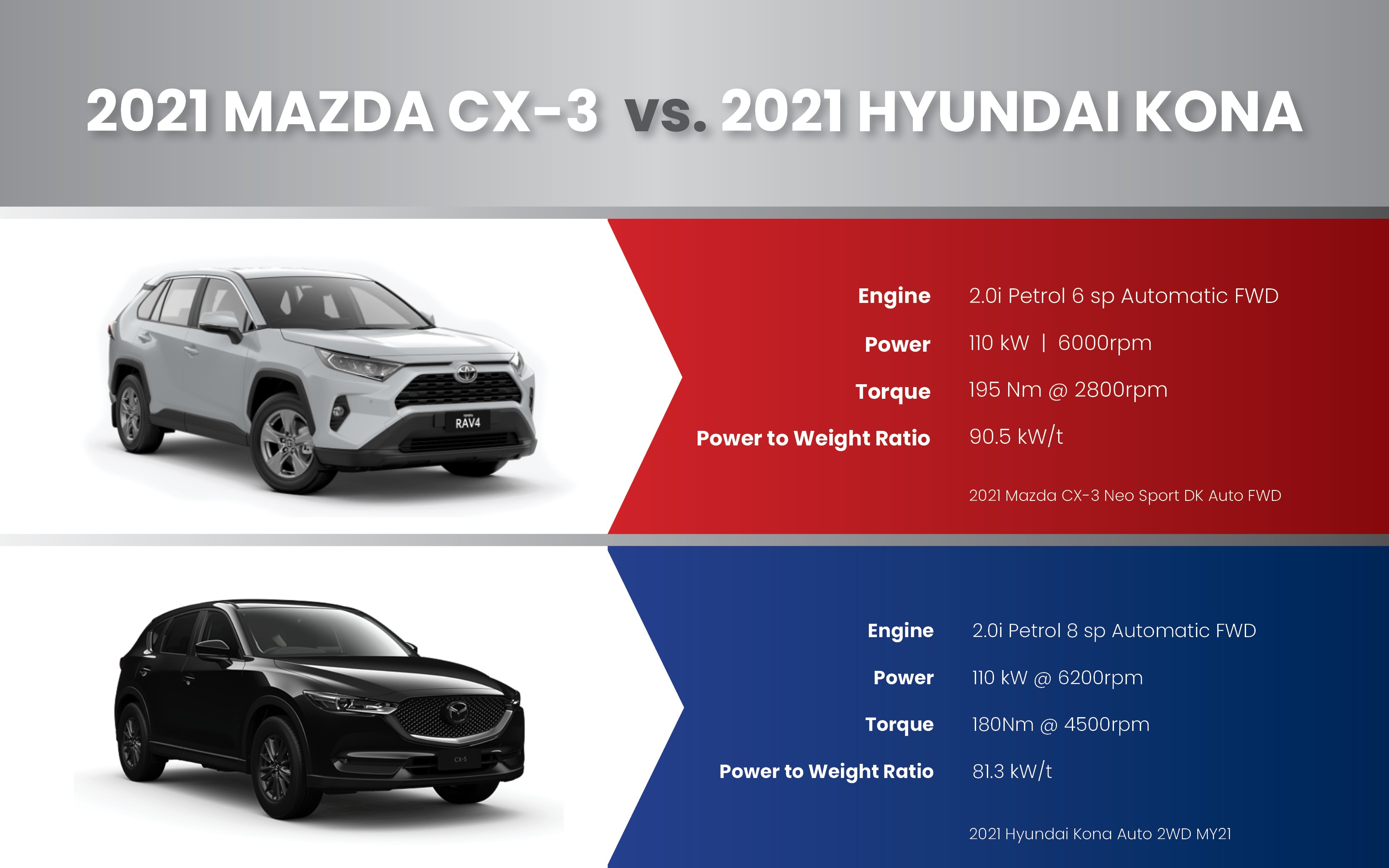
Mazda CX-3 vs Hyundai Kona 2021
Nobody would feel ashamed driving off the forecourt behind the wheel of either of these two highly successful compact SUVs.
Mazda has an enviable sporting pedigree, so it's almost inevitable that the CX-3 is designed to appeal to drivers who like to drive. Not only does it provide a great drive, but the CX-3 is also well-appointed and extremely safe. As you would expect from the 2020 best-selling light SUV in Australia, the CX-3 offers excellent all-around value.
This year, the Hyundai Kona has undergone a noticeable upgrade in its technology and styling, as well as a fresh engine. In addition, the N-line versions of the Kona provide sporty handling and performance that makes it a joy to drive. The Kona accounted for 23% of Hyundai's sales last year, so it's obviously a compact SUV that ticks quite a few boxes.
Here we tease out the differences between the two vehicles, giving prospective owners the information they need to assist decision-making.
The Basics
CX-3
The 2021 version benefits from a revamped, sporty exterior and some tech upgrades. Mazda has also created a 100th-anniversary CX-3, that benefits from unique paintwork and badges.
Related: Mazda CX-30 Review
Kona
Like the CX-3, the new Kona benefits from enhanced tech, as well as a new engine.

Interior
The interior of the CX-3 lives up to Mazda's emphasis on luxury. The cabin is well laid out and feels spacious for front-row passengers. Leather accents, chrome and soft-touch plastics form the bulk of the cabin materials.
The interior is more like you'd expect in a car, rather than an SUV. The driver's seat, for example, is in a very similar position to that of a standard car, rather than the higher SUV driving position.
Mazda's CX-3 is intended to seat five, but adult passengers will find the second row of seats a squeeze. Like many other compact SUVs, rear passengers will struggle to remain comfortable on longer trips. Luggage space is also limited.
Hyundai's Kona cabin varies between utilitarian and luxurious, depending on which spec you opt for. The Highlander and N-line premium benefit from leather upholstery, dual temperature control for the front seats, a sunroof and some extremely impressive tech. In contrast, the entry-level Kona has cloth upholstery, more basic air-con and acceptable, but not ground-breaking, tech.
Rear space is tight but no more than most other compact SUVs. Like the CX-3, the Kona isn't really designed for three adults to share the second row for longer distances. Luggage space is slightly more than the CX-3's, but not significantly so.
Discover The Best SUV's In Australia Under $30k
Exterior
One of the strong points of the CX-3 has traditionally been its sporty exterior. With sleek, racing lines, alloys and a front end with presence, it's an attractive SUV that certainly won't disgrace a drive who values street cred.
Similarly, the updated Kona N-line range incorporates details such as alloys, a mesh grille and some decorative front end vents. This gives it a sharp look that certainly enables it to hold its own.
Ultimately, though, both vehicles are SUVs, not roadsters. In addition, what really matters is what's under the bonnet, rather than the presence, or absence, of decorative front vents!
Performance
The CX-3 benefits from a 2.0l petrol engine that delivers 110kw and 195Nm of torque. Fuel efficiency is around 6.3l/100km for both the front wheel and AWD versions.
Kona drivers can choose between the standard 2.0l petrol variant and a 1.6l turbo that's used in the N series. The 2.0l petrol MP CVT 2WD delivers 110kw, 180 Nm of torque and 6.2l of petrol/100km. The 1.6l petrol Turbo-GDi, 7-speed DCT AWD offers 146kw and 265Nm of torque, along with 6.9l/100km petrol consumption.
Reviewers rave about the CX-3's handling, constancy throughout the revs and tuned suspension. They also mention engine noise and the lack of comfort that a stiffer suspension can bring on longer trips. The CX-3 is fast and handles like a dream, but its engine is quite basic.
Although the 2l Kona engine doesn't deliver the torque of the CX-3, the 1.6l turbo surpasses it. Particularly strong in off-road situations, the 1.6l Kona delivers plenty, but it does come at a premium price. The 1.6l also consumes significantly more petrol than its 2.0l competitors - a consideration if shorter, urban drives form the bulk of your kilometres.
Related: Top Cars Arriving in Australia in 2021
Highlights
CX-3
- A 100th-anniversary edition is available.
- Excellent driving experience.
- High-quality interior
Kona
- Amazing tech in the higher-spec versions. The Highlander includes a 10.25" infotainment screen, as well as LED headlights and taillights, and a smart key.
- The 1.6l turbo-engine that's incorporated in the N series offers a high level of power and performance.
- Plenty of tech add-ons and features, if you're prepared to pay for them.
Why You Should Buy the Mazda CX-3
The CX-3 is a good all-rounder with some serious performance under the bonnet. It's not the most sophisticated engine on the market, but it does have clout.
If you want torque, consistent acceleration throughout the range and beautiful cornering, the CX-3 is ideal. It's a driver's car, which is, perhaps, why it's such a success as an SUV. Once you get behind the wheel, it's easy to forget that this is a family-orientated, multi-purpose vehicle, rather than a hot hatch. Many vehicle owners want to enjoy the time they spend in their car. The CX-3's interior is a great place to be.
It's very safe and, whilst not incredibly spacious, rear seats and luggage space is on par with others in the class. If you want a more spacious vehicle, it's probably worth considering an upgrade to the CX-5. Ideal for shorter trips, urban travel and the occasional longer ride, the CX-3 is a sound choice for prospective SUV owners.
Why you should buy the Hyundai Kona
If you're prepared to pay more, the Kona has tech and engine options that are significantly more sophisticated than those available in the CX-3. The high-end, 10.5" infotainment screen found in the Highlander, for example, is much better than anything you're going to get in the Mazda.
For drivers who crave a sporty ride, the 1.6l turbo engine is going to deliver, albeit at a cost in terms of fuel consumption.
Reviewers also praise the comfort of the ride, as well as the wide range of safety features.
The customisable nature of the Kona enables it to appeal to almost any would-be SUV owner, provided the right combination of features is selected.
More: 2022 Hyundai Kona Review
Final Verdict
Like so many other things in life, the devil is in the detail when it comes to which of these two compact SUVs is going to be the best choice.
Both are safe, fuel-efficient vehicles that are more than able to complete the driving that's required of an average SUV. Ultimately, your choice will depend on what type of driving you do and how much you're prepared to pay for an SUV that exactly matches your requirements.
The starting price for the CX-3 is around $29,090. In contrast, the starting price for a Kona is around $26,600. What's important to note is that you don't get the same level of performance and range of features in the entry-level Kona as you do in the CX-3.
What the Kona offers is the chance to incorporate a wide variety of upgrades into your SUV. Each of which comes at a price. The CX-3 offers fewer options for add-ons but enters the market at a higher point. If you want a vehicle that does what it says on the tin (and delivers admirably), the CX-3 is going to be the better choice. For drivers who prefer to customise their vehicle, and who don't mind spending more to get exactly what they want then the Kona may well be the better option.
Find a Mazda CX-3 or Hyundai Kona on OnlyCars.com.au at a great price, with financing options available through Credit One - Australia's best-rated finance broker.


